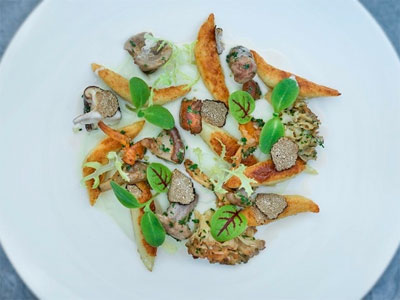The foodie revolution of King’s Cross is still going strong. German Gymnasium is the latest opening, a huge, German restaurant comprising an all-day café and patisserie counter on the ground floor, a large outdoor terrace, and an elegant restaurant and cocktail bar on the first floor. But what makes the venue extra-special is that it was once England’s very first purpose-built gym, constructed in 1865. Designers Conran & Partners have taken special care to ensure the Grade II listed building retains its Victorian heritage.
The menu is Central European, courtesy of executive chef Bjoern Wassmuth. Think classics like veal schnitzel and beef goulash, as well as more adventurous dishes such as the truffled beef broth with liver dumplings. There is also a vast wine list sourced from vineyards along the Danube river, highlighting niche German, Austrian, Hungarian and Eastern European labels.
Bjoern has worked all over the world on luxury cruise ships as well as in top German hotels. He joined the D&D Group in July 2015 (famous for owning Quaglino’s and Launceston Place among many others) and opened German Gymnasium a few months later.We caught up with Bjoern and snagged his recipe for schupfnudeln, his homeland’s famous dumpling-noodle hybrid.
How would you describe German food?
German cuisine is often thought of as being quite heavy, but considering it is influenced by many other European cuisines, it actually offers a quite attractive mix. It's definitely much more than just sausage and bread!
Do you think it will take off over here?
Londoners are always looking for new and interesting cuisines to try, and I think that is something the Mittel-European menus at German Gymnasium can certainly offer.
How can someone who is a novice attempt a good German dish?
Some German food, like sausages, can be quite simple to cook and rely more on using authentic ingredients than complicated techniques. Another good starting point is traditional baking recipes, as they often use fairly universal techniques.
Schupfnudeln & wild mushroom recipe
For the schupfnudeln:
750g potatoes
200g flour
2 eggs
nutmeg, salt
Boil the potatoes with skin until soft and let the steam out. Store overnight in the fridge.
Peel the potatoes and pass through a ricer, add egg and flour and season with nutmeg and salt to make a non-sticky dough.
Form schupfnudeln with the palm of your hands. Cook in simmering water until they float, remove and put them aside.
For the wild mushrooms:
300g mixed mushrooms
1 shallot, finely chopped
1 garlic clove, finely chopped
fresh parsley and chives, finely chopped
1 tbsp butter
salt and pepper
Clean the mushrooms and sauté with butter in a pan. Add the shallots and garlic. Season to taste and finish with the fresh herbs.
For the celeriac puree:
2 pieces celeriac root
250 ml milk
salt, white pepper
Peel the celeriac and cut into small dice. Cook in milk until soft, strain and puree in a blender.
Add cold butter to smooth. Season to taste.
For the beurre blanc:
2 shallots, finely chopped
50ml white Port
150 ml white wine
250 grams butter
Put the white port and white wine in a sauce pan together and reduce until it is a light syrup. Strain it and slowly whisk in cold butter into the liquid until you get a nice thick sauce. Keep it warm, but do not cook anymore.
To plate, put 2-3 spoons of puree on to a plate, assemble the schupfnudel and sprinkle the mushrooms over. Spoon the sauce around and garnish with some fresh herbs and fresh shaved winter truffles.
Read on to get the full lowdown on Schupfnudeln!
We chat to German Gymnasium's executive chef Bjoern Wassmuth

This article is connected to The German Gymnasium
Published Jan 25, 2016
